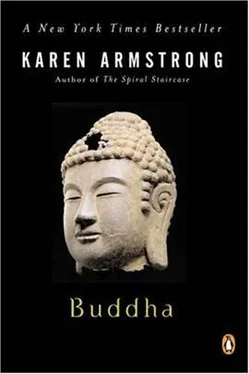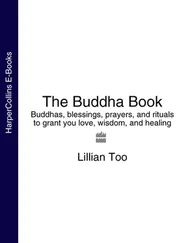The account of the Buddha’s attainment of enlightenment under the bodhi tree in the Pali texts can leave the modern reader feeling baffled and frustrated. It is one of the places where these Theravadin scriptures become opaque to people who are not expert yogins, since they dwell in such detail on meditative technicalities. More helpful to an outsider is the story told in the later scripture, the Nidana Katha, which makes the notion of enlightenment more accessible to ordinary mortals. As with its version of Gotama’s “Going Forth,” this story explores the psychological and spiritual implications of enlightenment in a way that a lay person or Buddhist beginner can understand, because it has no yogic jargon but gives us a wholly mythological account of the enlightenment. The author is not attempting to write history in our sense, but draws instead on timeless imagery to show what is involved in the discovery of Nibbana. He uses motifs common in mythology, which has been aptly described as a pre-modern form of psychology, tracing the inner paths of the psyche and making clearer the obscure world of the unconscious mind. Buddhism is an essentially psychological religion, so it is not surprising that the early Buddhist authors made such skillful use of mythology. Again, we must recall that none of these texts is concerned with telling us what actually happened, but rather is intended to help the audience gain their own enlightenment.
The Nidana Katha emphasizes the need for courage and determination: it shows Gotama engaged in a heroic struggle against all those forces within himself which militate against the achievement of Nibbana. We read that after Gotama had eaten his dish of junket, he strode as majestically as a lion toward the bodhi tree to make his last bid for liberation, determined to reach his goal that very night. First, he circled the tree, trying to find the place where all the previous Buddhas had sat when they had won through to Nibbana, but wherever he stood, “the broad earth heaved and sunk, as though it was a huge cartwheel lying on its hub, and somebody was treading on its rim.” Eventually, Gotama approached the eastern side of the tree, and when he stood there, the ground remained still. Gotama decided that this must be the “immovable spot” on which all the previous Buddhas had positioned themselves, so he sat down in the asana position facing the east, the region of the dawn, in the firm expectation that he was about to begin a new era in the history of humanity. “Let my skin and sinews and bones dry up, together with all the flesh and blood of my body! I will welcome it!” Gotama vowed. “But I will not move from this spot until I have attained the supreme and final wisdom.”
The text emphasizes the fantastic shuddering of the earth as Gotama circled the bodhi tree to remind us not to read this story literally. This is not a physical location: the world-tree, standing at the axis of the cosmos, is a common feature of salvation mythology. It is the place where the divine energies pour into the world, where humanity encounters the Absolute and becomes more fully itself. We need only recall the cross of Jesus, which, according to Christian legend, stood on the same spot as the Tree of Knowledge of Good and Evil in the Garden of Eden. But in Buddhist myth, Gotama the man sits in this pivotal place, not a man-God, because human beings must save themselves without supernatural aid. The texts make it clear that Gotama had come to this axis of the universe, the mythological center that holds the whole of the cosmos together. The “immovable spot” is that psychological state which enables us to see the world and ourselves in perfect balance. Without this psychological stability and this correct orientation, enlightenment is impossible: that is why all the Buddhas had to sit in this place-or achieve this state of mind-before they were able to attain Nibbana. It is the Axis Mundi, the still point of calm where human beings, in many world myths, encounter the Real and the Unconditioned; it is the “place” where things that seem diametrically opposed in the profane world come together in that coincidentia oppositorum that constitutes an experience of the Sacred. Life and death, emptiness and plenitude, physical and spiritual merge and conjoin, like the spokes of a wheel at its hub, in a way that is unimaginable to normal consciousness. When Gotama had reached the state of perfect equilibrium that he had glimpsed as a child under the rose-apple tree, when his faculties were concentrated and his egotism under control, he was, he believed, ready to sit in the “immovable spot.” He was at last in a position to receive the supreme insight.
But the struggle was not yet over. Gotama still had to fight those residual forces within himself which clung to the unregenerate life and did not want the ego to die. Mara, Gotama’s shadow-self, appeared before him, decked out like a cakkavatti, a World Ruler, with a massive army. Mara himself was mounted on an elephant that was 150 leagues high. He had sprouted 1,000 arms, each of which brandished a deadly weapon. Mara’s name means “delusion.” He epitomized the ignorance which holds us back from enlightenment, since, as a cakkavatti, he could only envisage a victory achieved by physical force. Gotama was still not fully enlightened, so he tried to respond in kind, seeing the virtues he had acquired as defensive weapons, as a sword or a shield that would destroy this deadly army. But, our author continues, despite Mara’s power, Gotama was sitting in the “unconquerable position,” proof against such vulgar coercion. When Mara hurled nine fearful storms against him, Gotama remained unmoved. The gods, who had gathered around to witness Gotama’s attainment of Nibbana, fled in terror, leaving him alone. When men and women seek salvation, in the Buddhist view, they can expect no divine support.
At this point, Mara approached Gotama and engaged him in a strange conversation. He told Gotama to “arise from this seat; it does not belong to you, but to me.” Gotama, Mara thought, had transcended the world; he was invulnerable to all external opposition. But Mara was the Lord of this world, and it was he, the cakkavatti, who should sit at its pivotal center. He did not realize that the rage, hatred and violence that he had just exhibited disqualified him from taking up his position under the bodhi tree, which belongs only to the man who lives by compassion. Gotama pointed out that Mara was quite unprepared for enlightenment; he had never made any spiritual efforts, had never given alms, had never practiced yoga. So, Gotama concluded, “this seat does not belong to you but to me.” He went on to add that in his previous lives he had given away all his possessions and had even laid down his life for others. What had Mara done? Could he produce witnesses to testify that he had performed such compassionate deeds? At once, Mara’s soldiers cried as one man: “I am his witness!” And Mara turned triumphantly to Gotama and asked him to validate his own claims.
But Gotama was alone; he had no human being or god on his side who could act as his witness to his long preparation for enlightenment. He therefore did something that no cakkavatti would ever do: he asked for help. Reaching out with his right hand to touch the ground, he begged the earth to testify to his past acts of compassion. With a shattering roar, the earth replied: “I bear you witness!” In terror, Mara’s elephant fell to its knees and his soldiers deserted, running in fear in all directions. The earth-witnessing posture, which shows the Buddha sitting in the cross-legged asana position, touching the ground with his right hand, is a favorite icon in Buddhist art. It not only symbolizes Gotama’s rejection of Mara’s sterile machismo, but makes the profound point that a Buddha does indeed belong to the world. The Dhamma is exacting, but it is not against nature. There is a deep affinity between the earth and the selfless human being, something that Gotama had sensed when he recalled his trance under the rose-apple tree. The man or woman who seeks enlightenment is in tune with the fundamental structure of the universe. Even though the world seems to be ruled by the violence of Mara and his army, it is the compassionate Buddha who is most truly in tune with the basic laws of existence.
Читать дальше












